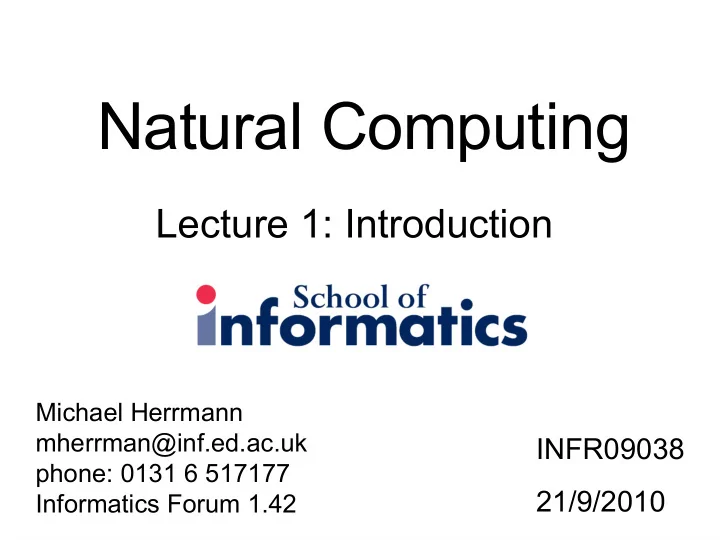

Natural Computing Lecture 1: Introduction Michael Herrmann mherrman@inf.ed.ac.uk INFR09038 phone: 0131 6 517177 21/9/2010 Informatics Forum 1.42
Natural Computation Physics Abacus Chemistry Slide ruler Biology Gear-driven calculating machines Relays, vacuum tubes, transistors ...
Natural Computation comprises three classes of methods: 1) those that employ natural materials (e.g., molecules) to compute; 2) those that are based on the use of computers to synthesize natural phenomena; and 3) those that take inspiration from nature for the development of novel problem-solving techniques http://en.wikipedia.org/wiki/Natural_computing
Computing with natural materials Analogue computers Smart matter Neural networks Membrane computing Molecular computing (DNA computing) Quantum computing Natural phenomena are used for information processing
Synthesizing natural phenomena in a computer L-systems Mechanical artificial life Artificial chemistry Synthetic biology Computational neuroscience Revealing computational principles that underlie natural phenomena
Inspiration from nature Cellular automata inspired by self-reproduction, Neural computation by the functioning of the brain, Evolutionary computation by the Darwinian evolution of species, Swarm intelligence by the behaviour of groups of organisms, Artificial immune systems by the natural immune system, Artificial life by properties of life in general, Membrane computing by the compartmentalized organization of the cells, and Amorphous computing by morphogenesis. L. Kari, G. Rozenberg, 2008. The many facets of natural computing. Comm. ACM 51, 10, 72-83.
Inspiration for problem solving (search for a good solution) Direct calculation, straight-forward recipe Decreasing domain knowledge Solution by analogy, generalization Cartesian method , divide and conquer Iterative solution, continuous improvement Heuristics and meta-heuristic algorithms Trial and error, random guessing
Optimization by hill-climbing
Meta-heuristic algorithms Similar to stochastic optimization Iteratively trying to improve a possibly large set of candidate solutions Few or no assumptions about the problem (need to know what is a good solution) Usually finds good rather than optimal solutions Adaptable by a number of adjustable parameters http://en.wikipedia.org/wiki/Metaheuristic
1. Chapter Genetic algorithms
Paralipomena Theory of natural evolution Genetics, genomics, bioinformatics The Philosophy of Chance (Stanislaw Lem, 1968 ) Memetics (R. Dawkins: The Selfish Gene , 1976) Neural Darwinism -- The Theory of Neuronal Group Selection (Gerald Edelman, 1975, 1989) (artificial) Immune systems Evolution of individual learning abilities, local heuristics Computational finance, markets, agents
Was conceived as an implementation of regulatory mechanisms in living beings (body temperature, blood pressure, …)
Switching dynamics “good” “bad” Implementation of switching in the homeostat Choose different dynamics by selecting different parameters
Translation: Homeostat → GA Homeostat Genetic algorithm Parameters {a ij } Genetic code Viability Fitness Dynamics Determination of fitness Partial re-selection of Mutation new parameters -- Recombination
Start Experimental contour optimization of a supersonic flashing flow nozzle Evolution (1967-1969) Hans-Paul Schwefel Result
Genetic Algorithms global search heuristics technique used in computing find exact or approximate solutions to optimization problems Applications in Bioinformatics Phylogenetics Computational science Engineering Robotics Economics Chemistry Manufacturing Mathematics Physics
The Golem Project Hod Lipson & Jordan B. Pollack (2000)
Genetic Programming (GP) Evolutionary algorithm-based methodology inspired by biological evolution Finds computer programs that perform a user-defined task Similar to genetic algorithms (GA) where each individual is a computer program Optimize a population of computer programs according to a fitness landscape determined by a program's ability to perform a given computational task.
Evolutionary Computation (EC) Genetic algorithms: Solution of a problem in the form of strings of numbers using recombination and mutation Genetic programming: Evolution of computer programs Evolutionary programming: Like GP, but only the parameters evolve Evolution strategies: Vectors of real numbers as representations of solutions
Natural Computation (NC) Evolutionary Computation Artificial immune systems Neural computation Amorphous computing Ant colony optimization Swarm intelligence Harmony search Cellular automata Artificial life Membrane computing Molecular computing Quantum computing
Problem Solving by GA Choosing the best option from some set of available alternatives Minimize energy, time, cost, risk, … Maximize gains, acceptance, turnover, … Discrete cost: − admissible goal state: maximal gain − anything else: no gain Secondary costs for: − acquisition of domain knowledge − testing alternatives − doing nothing − determining costs
Syllabus Part 1: Genetic algorithms (GAs) − The canonical genetic algorithm − The schema theorem and building block hypothesis − Formal analysis of genetic algorithms − Methodology for genetic algorithms − Designing real genetic algorithms − Multi-objective optimization Part 2: Evolving programs and intelligent agents − Genetic programming
Syllabus (continued) Part 3: Optimisation Problems − Evolutionary computing − Ant colony optimisation (ACO) − Particle swarms − Differential evolution Part 4: Artificial immune systems Part 5: Artificial life Part 6: Material computing
Reading suggestions Leandro Nunes de Castro (March 2007). Fundamentals of Natural Computing: An Overview. Physics of Life Reviews 4: pp.1–36. L. N. de Castro: Fundamentals of Natural Computing: Basic Concepts, Algorithms, and Applications. Chapman & Hall/CRC, 2006. G. Rozenberg, T. Bäck, J. N. Kok (Editors) Handbook of Natural Computing Springer Verlag, 2010. [for reference only, don't think of buying it] Melanie Mitchell: An Introduction to Genetic Algorithms. MIT Press, 1996. J. R. Koza: Genetic Programming: On the programming of computers by means of natural selection, MIT Press, 1992. Wolfgang Banzhaf, Peter Nordin, Robert E. Keller and Frank D. Francone: Genetic Programming: An Introduction. Morgan Kaufmann, 1988. Eric Bonabeau, Marco Dorigo and Guy Theraulez: Swarm Intelligence: From Natural to Artificial Systems. Oxford University Press, 1999.
Course organization Tuesday & Friday 15:00 – 15:50 at AT LT2 LT1 Assignments: two assignment together worth 30% (10% + 20%) of the course mark, to be handed in at the end of Week 5 and the end of Week 9. on 14 Oct / 18 Nov (both Thursdays 4pm) Exam: worth 70% of the course mark, taken at the end of Semester 2. Visiting students can take the exam at the end of Semester 1. michael.herrmann@ed.ac.uk phone: 0131 6 517177 Informatics Forum 1.42 Tutorials Mondays group 1: 16:10-17:00 (AT 4:07) Tuesdays group 2: 13:05-13:55 (AT 4.14a) Wednesdays group 3: 12:10-13:00 (AT 4.14a) group 4: 13:05-13:55 (AT 4:14a)
Recommend
More recommend